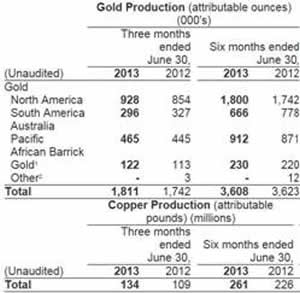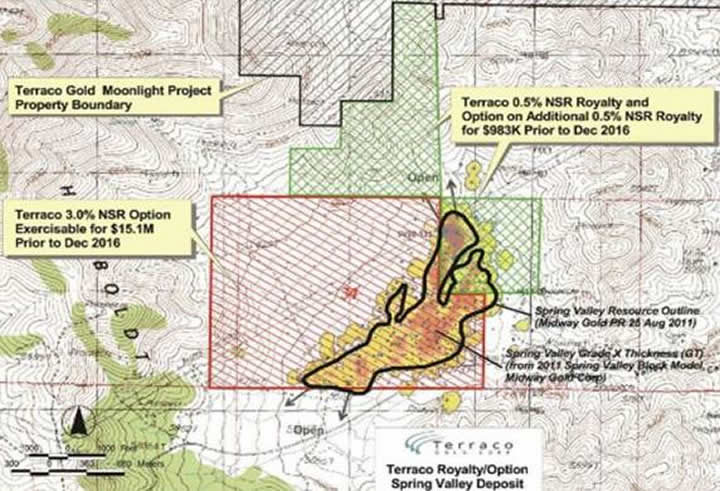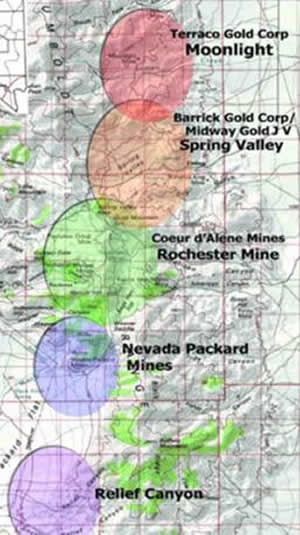Barrick Gold Miner Gets 10 out of 10
Commodities / Gold and Silver Stocks 2013 Sep 14, 2013 - 10:39 AM GMTBy: Richard_Mills
 Barrick Gold Corp. wasn’t always a gold miner, it started as a privately held oil and gas company - Barrick Resources. After suffering huge financial losses Peter Munk, the principal shareholder, decided to focus on gold.
Barrick Gold Corp. wasn’t always a gold miner, it started as a privately held oil and gas company - Barrick Resources. After suffering huge financial losses Peter Munk, the principal shareholder, decided to focus on gold.
The company’s first acquisition, in 1984, was the Renabie mine near Wawa, Ontario and it produced roughly 16,000 ounces of gold that year for Barrick. Then Barrick acquired Camflo Mining in 1984, Camflo had operations in the province of Quebec and in Nevada, U.S.A.
Barrick’s next acquisition was the Mercur mine in Mercur, Utah in June 1985, followed by the Goldstrike mine, in Nevada, in 1986.
Munk’s change of focus to gold paid off handsomely, acquisition after acquisition pole vaulted his Barrick to the top tier of the gold mining world.
Today Barrick Gold Corp. is the world’s lowest-cost senior gold producer (all-in sustaining cost basis) and is also the world's largest gold producer. The company’s 2013 full year gold production guidance is 7.0-7.4 million ounces from a portfolio that includes some of the world’s premier gold assets. As of December 31, 2012, Barrick’s proven and probable mineral reserves were 140.2 million ounces of gold, 1.05 billion ounces of silver contained within its gold reserves, and 13.9 billion pounds of copper. Barrick replaced proven and probable gold reserves for the seventh straight year in 2012.
In 2012, Barrick produced 7.4 million ounces of gold at all-in sustaining costs of $918 per ounce and total cash costs of $558 per ounce.
It’s obvious Barrick is something special in the world of gold mining, but what exactly makes Barrick stand so tall? Well, Barrick considers five of its mines as key assets – Cortez (N), Goldstrike(N), Pueblo Viejo, Veladero and Lagunas Norte. These five mines (two are in Nevada) are expected to generate some 60 percent of 2013 production at an average all-in sustaining costs (AISC) of $650-$700 per ounce.
Of the 2013 exploration budget of $300-$320 million, more than 40 percent is allocated to North America, primarily Nevada. And for good reason…


At double the gold production from Barrick’s next largest area of operation (Australia/Pacific) and with an all in sustaining cost of just $789 an ounce average there’s no doubt of Nevada’s importance to Barrick.
Nevada Operations
The Bald Mountain mine lies 110 kilometers southeast of Elko, Nevada. Probable mineral reserves as of December 31, 2012, were 5.2 million ounces of gold.
The Cortez mine is located 100 kilometers southwest of Elko, Nevada in Lander County. Cortez is one of the world’s largest and lowest cost gold mines, and the property also has excellent upside exploration potential. In the first half of 2013, the mine produced 760,000 ounces of gold at all-in sustaining costs of $392 per ounce and adjusted operating costs of $179 per ounce. Proven and probable mineral reserves as at December 31, 2012, were 15.1 million ounces of gold.
The Goldrush discovery is located approximately 6 kilometers from the Cortez mine in Nevada. There is a measured and indicated resource of 8.4 million ounces as of December 31, 2012 - there are 5.7 million ounces in the inferred category. The footprint of the deposit is greater than seven kilometers and the system remains open in multiple directions. The greater Cortez area contains substantial district-scale opportunities.
The Goldstrike Complex is 60 kilometers northwest of Elko, Nevada. In the first half of 2013, the Goldstrike Property produced 417,000 ounces of gold. Goldstrike’s proven and probable mineral reserves as at December 31, 2012, were 12.3 million ounces of gold.
Marigold is located 64 kilometers southeast of Winnemucca, Nevada. Barrick has a 33% interest in the mine with the remaining interest owned by Goldcorp. In the first half of 2013, Barrick’s share of production was 27,000 ounces of gold. Barrick’s share of proven and probable mineral reserves as at December 31, 2012, was 1.6 million ounces of gold.
Located almost 100 kilometers north of Tonopah in Nye County, Nevada, Round Mountain is a joint venture operation in which Barrick holds a 50% interest with Kinross Gold Corporation — the operator owns the other 50%. In the first half of 2013, Barrick’s share of production was 76,000 ounces of gold. Barrick’s share of proven and probable mineral reserves as at December 31, 2012, was 1.2 million ounces of gold.
The Ruby Hill mine is located less than one kilometer from the town of Eureka and is 193 kilometers south of the Goldstrike Property. In the first half of 2013, Ruby Hill produced 32,000 ounces of gold. Proven and probable mineral reserves as at December 31, 2012, were 326,000 ounces of gold.
The Spring Valley deposit is a large, porphyry hosted gold resource located in the Spring Valley Mining District, Pershing County, Nevada, approximately 20 miles northeast of the town of Lovelock. A May 2011 updated resource estimate released by JV partner Midway Gold reported 2.16 million ounces of gold in the combined Measured and Indicated (M&I) categories plus an additional 1.97 million ounces of gold in the Inferred (I) category. Barrick’s in the process of earning a 70% interest in Spring Valley.
A Nevada JV
The Barrick Nevada project that I find most interesting is the joint venture with junior resource company Midway Gold at Spring Valley.
Barrick took down several placements with Midway, all earmarked for Spring Valley, and later signed a JV deal where Barrick is funding 100% of the costs to earn an interest in this project.
Barrick reported in April 2013 that they had exceeded the cumulative expenditure requirement of $30M to earn a 60% interest in the property. They also exercised, much earlier than they had to, their option to spend an additional $8 million to earn a 70% interest. At the current rate of expenditure, Midway anticipates that Barrick will complete the cumulative expenditure of $38 million to earn a 70% interest in the project by the end of 2013.
At this point Midway can elect to have a carried to production 25% piece of Spring Valley. Midway would pay back its share of the capital out of 90% of its cash flows from Spring Valley at a rate of prime +2%.
The just completed 2013 drilling program (11,996 meters in 24 RC holes and 8,840 meters in 26 core holes) was focused on upgrading the quality of the resource for future reserve calculations.
Recent drilling highlights include:
SV13-625
113 meters of 4.53 grams per tonne (gpt) gold including 9 meters of 15.81 gpt gold, 18 meters of 9.5 gpt gold and 8 meters of 12.86 gpt
102 meters of 3.15 gpt gold including 1.5 meters of 62.19 gpt gold and 1.5 meters of 46.80 gpt gold
SV13-629
56 meters of 1.51 gpt gold including 1.5 meters of 27.7 gpt gold
55 meters of 1.10 gpt gold including 1.5 meters of 5.45 gpt gold
Additional expansion potential for the Spring Valley deposit remains at depth and to the north.
Midway Gold is a high quality investable gold junior and of course they have other irons in the fire besides their JV with Barrick. High quality juniors are hard enough to find, one with money in the bank, working in one of the best areas in the world - Nevada - for mining exploration and development and a JV with the world’s premier gold miner makes Midway one to have on your radar screen.
But what if I told you there was another way, perhaps an even more lucrative way of getting invested with the world’s lowest cost gold producer putting Spring Valley into production?
Terraco Gold Corp. (TSX.V – TEN) has a gold royalty and royalty option (up to a 3% NSR) on the Spring Valley Gold Project.
Royalty - the right to receive a percentage or other denomination of mineral production from a resource extraction operation.
Net Smelter Return (“NSR”) Royalty - a defined percentage of the gross revenue from a resource extraction operation, less a proportionate share of incidental transportation, insurance, refining and smelting costs.

Terraco's net smelter returns ("NSR") royalty coverage includes three separate components. The map above and color codes provides a schematic of the royalties:
- An option to acquire up to a 3.0% NSR royalty (by December 2016) on claims covering (outlined in RED hatching on map above) the majority of the currently outlined Spring Valley gold deposit
- A total of up to a 1% NSR royalty on the remaining portion (outlined in GREEN hatching on map above) of the currently outlined Spring Valley gold deposit as well as areas to the north of the currently outlined NI 43-101 gold resource
- (Per #2, Terraco currently has direct ownership of 0.5% NSR royalty plus an option (by December 2016) to purchase an additional 0.5% NSR royalty for a total of up to 1% NSR)
- Terraco has a Right of First Refusal (ROFR) for a 1% NSR royalty on claims within a one-half (1/2) mile perimeter area of interest (around the claims in RED)
The royalty transactions on the Barrick-led Spring Valley Project have not only given Terraco a non-dilutive cash infusion of US$6,000,000 but also gave the company what in reality is an ATM card. TEN can use that ATM card and pull out millions of dollars in future non-dilutive financings in order to fund the company going forward by selling pieces or small percentages of the royalty.
The numbers flowing to Terraco over the life of the Spring Valley mine (life of mine - LOM) are very lucrative. I’m a very conservative numbers guy - start with a mineable resource of 4m ounces gold, 250,000 ounces mined per year for 16 years at an all in sustaining cost of $900 an ounce – Nevada’s average for Barrick. Today’s gold price of $1400.00 an ounce (minus $900) flows to TEN $3.75 million per year for 16 years or $60m over LOM. These are my own conservative calculations based on a 43-101 resource of 4m ounces that is over 2+ years old. The resource numbers should be higher based on the last 2 years of Barrick drilling, including the best ever holes released within the project area, so there is lots of cushion built in to the upside.
 But Terraco isn’t a one trick pony…
But Terraco isn’t a one trick pony…
Terraco also controls the over 35 sq km Moonlight Project, a contiguous land package connected to the north side of the Spring Valley project. The Moonlight Project is one of the largest early stage properties remaining on the Humboldt Trend and the company has been quietly consolidating and increasing its land position over the last three years.
Moonlight lies just eight km north of Coeur’s Rochester silver-gold mine. The Rochester mine has produced over 125 million ounces of silver and well over one million ounces of gold in its 24 year history.
The Black Ridge Fault Zone's eastern boundary controls the eastern margin of precious metals mineralization at Rochester. Drilling at Moonlight indicates that this district-scale fault system continues through the Moonlight Project properties. Barrick's drilling confirms the Spring Valley deposits gold mineralization is open to the north (towards Moonlight) and at depth.
So there is evidence to suggest that Moonlight could be the next mineralized event in a string of deposits on the Humboldt Trend ranging from Relief Canyon at the south end, north through Nevada Packard, Rochester, Spring Valley and Moonlight.
In addition to the Spring Valley Royalty and it’s Moonlight Project, Terraco has an advanced-stage gold project in Idaho (the Nutmeg Mountain / Almaden Project) which hosts a National Instrument 43-101 compliant gold resource of almost one million ounces. This advanced-stage project has excellent access and infrastructure and has over 66,140 meters of drilling in 903 drill holes.
The project is host to a low-sulphidation, epithermal gold deposit that sits on the side of Nutmeg Mountain, you would push material down to end up on a leach pad, there’s no stripping ratio to speak of and there’s already landslide material at the bottom - the inferred resource of 84,000 ozs of gold.
Conclusion
I do not believe Barrick will drop Spring Valley, they have invested too much money to walk away from their share of 4.1m ounces of gold (and growing) which is still open to depth and to the north. Barrick obviously feels at home and is very comfortable working in Nevada. The only possible negative about the Spring Valley JV is if Barrick completes its earn in and then puts the project on hold. Of course if that is the plan why complete an early earn in? Why hurry up and wait when they could of just completed their earn in on schedule.
Let’s recap:
- Early private placements into Midway specifically earmarked for Spring Valley
- The world’s premier gold miner then entered into a JV paying 100% of the costs and carrying Midway to production
- An early earn in for Barrick
- 4.1mm ozs of gold and growing
- Deposit open to depth and to the north
- A politically safe, mining friendly place like Nevada
Imagine having a 3% royalty on all of the above! Well Terraco Gold TSX.V – TEN does and that royalty has to look desirable to a number of companies, not the least of which may be Barrick itself.
Spring Valley, Moonlight and Almaden all make for a very bright future for Terraco Gold TSX.V – TEN. Todd Hilditch, Terraco’s president and CEO certainly seems to think so having bought well over a million shares in the last year. Other insiders and employees of the company have also been buying in the open market at a prodigious pace. Given all these factors Terraco is one junior resource company we should all have on our radar screen. Is a TEN out of ten on yours?
If not, maybe one should be.
By Richard (Rick) Mills
If you're interested in learning more about the junior resource and bio-med sectors please come and visit us at www.aheadoftheherd.com
Site membership is free. No credit card or personal information is asked for.
Richard is host of Aheadoftheherd.com and invests in the junior resource sector.
His articles have been published on over 400 websites, including:
Wall Street Journal, Market Oracle, USAToday, National Post, Stockhouse, Lewrockwell, Pinnacledigest, Uranium Miner, Beforeitsnews, SeekingAlpha, MontrealGazette, Casey Research, 24hgold, Vancouver Sun, CBSnews, SilverBearCafe, Infomine, Huffington Post, Mineweb, 321Gold, Kitco, Gold-Eagle, The Gold/Energy Reports, Calgary Herald, Resource Investor, Mining.com, Forbes, FNArena, Uraniumseek, Financial Sense, Goldseek, Dallasnews, Vantagewire, Resourceclips and the Association of Mining Analysts.
Copyright © 2013 Richard (Rick) Mills - All Rights Reserved
Legal Notice / Disclaimer: This document is not and should not be construed as an offer to sell or the solicitation of an offer to purchase or subscribe for any investment. Richard Mills has based this document on information obtained from sources he believes to be reliable but which has not been independently verified; Richard Mills makes no guarantee, representation or warranty and accepts no responsibility or liability as to its accuracy or completeness. Expressions of opinion are those of Richard Mills only and are subject to change without notice. Richard Mills assumes no warranty, liability or guarantee for the current relevance, correctness or completeness of any information provided within this Report and will not be held liable for the consequence of reliance upon any opinion or statement contained herein or any omission. Furthermore, I, Richard Mills, assume no liability for any direct or indirect loss or damage or, in particular, for lost profit, which you may incur as a result of the use and existence of the information provided within this Report.
Richard (Rick) Mills Archive |
© 2005-2022 http://www.MarketOracle.co.uk - The Market Oracle is a FREE Daily Financial Markets Analysis & Forecasting online publication.



